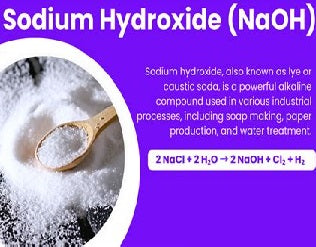
The Role of Sodium Hydroxide in Skin Care
Sodium hydroxide, commonly known as lye or caustic soda, is a chemical that often raises eyebrows when found in skin care products. While it may sound alarming due to its caustic nature, sodium hydroxide serves essential functions in many beauty formulations. This article delves into the benefits and roles of sodium hydroxide in skin care, its safety profile and what consumers should consider when using products containing this ingredient.
Understanding Sodium Hydroxide
Sodium hydroxide is a strong alkaline compound that appears as solid white crystals. It is widely used in various industries, including soap making, cleaning products and food processing. In the realm of skin care, sodium hydroxide is often utilized for its ability to balance pH levels, which is crucial for maintaining healthy skin.
Why Is Sodium Hydroxide Used in Skin Care?
1. pH Balancing: The skin’s natural pH typically ranges from 4 to 7, making it slightly acidic. Many skin care products aim to maintain this balance to protect the skin's acid mantle, which helps retain moisture and ward off harmful bacteria. Sodium hydroxide is used to adjust the pH of formulations, ensuring they are compatible with the skin.
2. Saponification: In the soap-making process, sodium hydroxide reacts with fats and oils to create soap through a chemical reaction known as saponification. This process transforms oily substances into a cleansing product, making sodium hydroxide integral in many soaps and cleansers.
3. Stabilizing Agent: Sodium hydroxide helps stabilize certain formulations, ensuring that the product remains effective over time. This is particularly important for creams and lotions, where ingredient stability is key to product performance.
Safety Profile of Sodium Hydroxide
Low Concentrations Are Key
In skin care products, sodium hydroxide is typically present in low concentrations, making it safe for general use. When applied in small amounts, it is unlikely to cause adverse reactions. However, concerns arise from its potential at higher concentrations, where it can cause chemical burns and irritation.
Potential Side Effects
While sodium hydroxide is considered safe in cosmetic formulations, individuals with sensitive skin may experience reactions, including:
- Irritation: Redness, itching, or flaking may occur, especially for those with pre-existing skin conditions.
- Chemical Burns: Direct application of concentrated sodium hydroxide can lead to severe burns, highlighting the importance of using products formulated correctly.
Patch Testing
For those unsure about how their skin will react to products containing sodium hydroxide, conducting a patch test is advisable. Apply a small amount of the product to a discreet area of skin and monitor it for 24 hours for any adverse reactions.
The Benefits of Sodium Hydroxide in Skin Care
1. Improved Skin Texture: By maintaining an optimal pH balance, sodium hydroxide can help prevent issues like dryness and irritation, leading to smoother, healthier skin.
2. Enhanced Product Efficacy: The role of sodium hydroxide in stabilizing formulations ensures that active ingredients remain effective. This can lead to better results for consumers using treatments for acne, aging, or pigmentation issues.
3. Cleansing Properties: In soaps and cleansers, sodium hydroxide facilitates the breakdown of oils and dirt, effectively cleansing the skin without stripping it of essential moisture when used correctly.
Considerations for Consumers
Ingredient Awareness
Consumers should be mindful of the ingredients in their skin care products. While sodium hydroxide is safe in low concentrations, it’s essential to choose reputable brands that prioritize safety and efficacy.
Seeking Alternatives
For individuals with sensitive skin or specific skin concerns, alternatives to products containing sodium hydroxide may be worth exploring. Ingredients like citric acid or other gentle pH adjusters can provide similar benefits with potentially less irritation.
Conclusion
Sodium hydroxide plays a crucial role in many skin care products, offering benefits such as pH balancing, stabilization and cleansing properties. While it is generally safe when used in low concentrations, individuals should always be aware of their skin’s sensitivities and perform patch tests when trying new products.
By understanding the functions and safety of sodium hydroxide, consumers can make informed choices about their skin care routines, leading to healthier and more radiant skin.
Sources:
1. American Academy of Dermatology - Skin Care Ingredients to Know Link
2. FDA - Cosmetic Ingredients: Safety and Regulation Link
3. Dermatology Times - The Role of pH in Skin Care Link